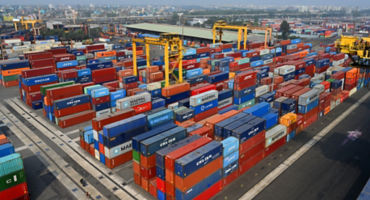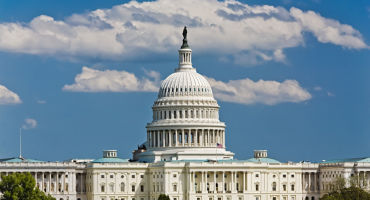- Macro Strategist
Skip to main content
- Funds
- Capabilities
- Insights
- About Us
Asset classes
Hong Kong (香港), Individual
Changechevron_rightThe views expressed are those of the author at the time of writing. Other teams may hold different views and make different investment decisions. The value of your investment may become worth more or less than at the time of original investment. While any third-party data used is considered reliable, its accuracy is not guaranteed.
Before I unpack the economic and market implications of the sweeping tariffs the Trump administration introduced on April 2 (which have raised the effective tariff rate to the highest level since the 1930s), I want to acknowledge that this is an early response* to a nascent policy. The situation will very likely evolve, and I believe actual tariff rates may end up varying day to day or week to week.
As part of this new policy, a universal 10% tariff on all countries will take effect on April 5. Additional, “reciprocal” tariffs will be implemented on April 9. These are a purported response to tariffs imposed by other nations toward the US. The presidential administration asserts these tariffs represent half the rate of the tariffs imposed toward the US by other countries and positions this halving as a kindness on the part of the US.
There are a few particularly notable aspects of the new policies I’d like to point out. First, the tariff rate for China appears to be “stacking,” meaning that while the new, “reciprocal” tariff is 34%, the effective rate is 54% given 20% was imposed earlier this year. It also ends duty-free de minimis treatment for covered goods. Next, exemptions to future Section 232 tariffs — applied to gold, autos, and energy/critical materials — were mentioned. Investigations into pharma and semiconductors are expected, as well. Finally, on a relative basis, Canada and Mexico will continue to receive no tariffs on USMCA-compliant goods, a 25% tariff on non-USMCA compliant goods, and a 10% tariff on non-USMCA-compliant energy and potash.
Let’s turn our attention back to timing. In theory, because the “reciprocal” tariffs are meant to be enacted a week after the announcement was made, there is room for negotiation. In my view, the administration is likely calculating that using an aggressive starting point increases the probability that other countries make concessions, which the US could accept before/immediately following implementation. I suspect the administration would view such concessions as both a testament to US strength and a means of retaining some revenue from a fiscal perspective. The latter point is important — a reconciliation process may lead to higher debt levels over the medium term with a current policy baseline and the addition of further tax cuts beyond the extension of the Tax Cuts and Jobs Act (TCJA).
As part of this conversation, it’s worth noting the April 2 judicial election results revealed that voters are souring on the Trump administration. This type of feedback can be a disciplinarian, but President Trump is steadfast in his conviction in the efficacy of tariffs, which he seems to view as a solution to structural issues around labor share of income and income inequality. It remains to be seen whether they will achieve the desired outcome over time.
The magnitude of the tariffs will erode, if not destroy, trust among US allies. A loss of trust may make allies less likely to engage in negotiations than the administration bargains on — a dynamic that is likely to become clearer in the coming days. What’s more, a decline in institutional integrity undermines the status of the US dollar as reserve currency. This risk has now accelerated, and even if the administration walks the tariffs back before implementation, this is unlikely to dissipate. In the short and medium term, these actions:
This all said, I’ll be surprised if all these tariffs go into effect as announced, which makes analysis of the situation difficult. Uncertainty multiplier effects can be large — especially when bilateral negotiations with 60 countries may be looming large and potential shifts in tariff rates by the day/week are likely.
*Response written on April 3, 2025.
Expert

Navigate volatility with Wellington

Trump win likely to accelerate macro trends already in motion
The US election results could have significant implications for the global economy and markets. To help you understand these changes, US Macro Strategist Mike Medeiros provides a thorough analysis and discusses the potential market impacts.

What do the US election results mean for investors?
The US election results could have significant implications for the global economy and capital markets. Our panel of experts provides a thorough analysis of what happened and explores potential market impacts.
Multiple authors

Four investment perspectives amid a pivotal US election
How can investors reposition portfolios for a pivotal but highly unpredictable US elections? Nick Samouilhan explores potential avenues in conversation with three leading portfolio managers.
Multiple authors

Fiscal versus tariffs: what wins out for Europe?
Just as investors were starting to explore the potential for growth in Europe, Trump’s tariffs landed. To what extent is the case for Europe still intact?

How China can offset the tariff shock
Macro Strategist Johnny Yu details the approaches Beijing could take to offset the tariff shock, from fiscal strategies to potential retaliatory measures to concessions that Washington may welcome.

What do tariffs mean for portfolios?
Tariffs exceeded market expectations. Now what? Expect short-term volatility, identify concentrations and consider using sell-offs as an entry point to diversify across regions and styles, says Nanette Abuhoff Jacobson, Global Investment and Multi-Asset Strategist.

Could “Liberation Day” trigger a shift in capital flows?
John Butler discusses groundbreaking US tariffs, their impact on capital flows, and the changing investor perception of the US and Europe.
By

Chart in Focus: how sustainable is Europe’s rally?
Is the recent rally in European equities sustainable? In this edition of our Chart in Focus series, we explore the potential path ahead.
Multiple authors

What does Trump's US election win mean for bond investors?
During the week of US election, Paul Skinner interviews Connor Fitzgerald, Fixed Income Portfolio Manager, on the market implications and his portfolio positioning following the presidential election results.

It’s different this time: Trump faces challenging geopolitical dynamics
Our expert explores how Trump may approach the heightened geopolitical challenges his second administration faces.
By

Trump win likely to accelerate macro trends already in motion
The US election results could have significant implications for the global economy and markets. To help you understand these changes, US Macro Strategist Mike Medeiros provides a thorough analysis and discusses the potential market impacts.

What do the US election results mean for investors?
The US election results could have significant implications for the global economy and capital markets. Our panel of experts provides a thorough analysis of what happened and explores potential market impacts.
Multiple authors

Four investment perspectives amid a pivotal US election
How can investors reposition portfolios for a pivotal but highly unpredictable US elections? Nick Samouilhan explores potential avenues in conversation with three leading portfolio managers.
Multiple authors

Fiscal versus tariffs: what wins out for Europe?
Just as investors were starting to explore the potential for growth in Europe, Trump’s tariffs landed. To what extent is the case for Europe still intact?

How China can offset the tariff shock
Macro Strategist Johnny Yu details the approaches Beijing could take to offset the tariff shock, from fiscal strategies to potential retaliatory measures to concessions that Washington may welcome.

What do tariffs mean for portfolios?
Tariffs exceeded market expectations. Now what? Expect short-term volatility, identify concentrations and consider using sell-offs as an entry point to diversify across regions and styles, says Nanette Abuhoff Jacobson, Global Investment and Multi-Asset Strategist.

Could “Liberation Day” trigger a shift in capital flows?
John Butler discusses groundbreaking US tariffs, their impact on capital flows, and the changing investor perception of the US and Europe.
By

Chart in Focus: how sustainable is Europe’s rally?
Is the recent rally in European equities sustainable? In this edition of our Chart in Focus series, we explore the potential path ahead.
Multiple authors

What does Trump's US election win mean for bond investors?
During the week of US election, Paul Skinner interviews Connor Fitzgerald, Fixed Income Portfolio Manager, on the market implications and his portfolio positioning following the presidential election results.

It’s different this time: Trump faces challenging geopolitical dynamics
Our expert explores how Trump may approach the heightened geopolitical challenges his second administration faces.
By

Trump win likely to accelerate macro trends already in motion
The US election results could have significant implications for the global economy and markets. To help you understand these changes, US Macro Strategist Mike Medeiros provides a thorough analysis and discusses the potential market impacts.

What do the US election results mean for investors?
The US election results could have significant implications for the global economy and capital markets. Our panel of experts provides a thorough analysis of what happened and explores potential market impacts.
Multiple authors

Four investment perspectives amid a pivotal US election
How can investors reposition portfolios for a pivotal but highly unpredictable US elections? Nick Samouilhan explores potential avenues in conversation with three leading portfolio managers.
Multiple authors
URL References
Related Insights
DISCLOSURE
This material and its contents may not be reproduced or distributed, in whole or in part, without the express written consent of Wellington Management. This document is intended for information purposes only. It is not an offer or a solicitation by anyone, to subscribe for shares in Wellington Management Funds (Luxembourg) III SICAV (the Fund). Nothing in this document should be interpreted as advice, nor is it a recommendation to buy or sell shares. Investment in the Fund may not be suitable for all investors. Any views expressed are those of the author at the time of writing and are subject to change without notice. Investors should carefully read the Key Facts Statement (KFS), Prospectus, and Hong Kong Covering Document for the Fund and the sub-fund(s) for details, including risk factors, before making an investment decision. Other relevant documents are the annual report (and semi-annual report).
© 2025 Morningstar, Inc. All Rights Reserved. The information contained herein: (1) is proprietary to Morningstar; (2) may not be copied or distributed; and (3) is not warranted to be accurate, complete or timely. Neither Morningstar nor its content providers are responsible for any damages or losses arising from any use of this information. The Overall Morningstar Rating for a fund is derived from a weighted average of the three, five, and ten year (if applicable) ratings, based on risk-adjusted return. Past performance is no guarantee of future results.
Issued by Wellington Management Hong Kong Limited. Investment involves risk. Past performance is not indicative of future performance. This document has not been reviewed by the Securities and Futures Commission of Hong Kong.
We seek to exceed the investment objectives and service expectations of our fund investors and their advisers worldwide
© Copyright 2025 Wellington Management Hong Kong Limited. All rights reserved.
WELLINGTON MANAGEMENT® is a registered service mark of Wellington Group Holdings LLP.
Wellington Management Hong Kong Limited 威靈頓管理香港有限公司 is a private company incorporated with limited liability in Hong Kong, with its address at 17/F Two International Finance Centre, 8 Finance Street, Central, Hong Kong. It is licensed and regulated by the Securities and Futures Commission of Hong Kong with CE Number AJB478.